What Are Poles and Throws in a Switch? | Types, Configurations, and Examples
Published on July 14, 2024 | Category: connectionShare this Page:
A switch is an electrical device used to make or break the connection in a circuit. It allows current to flow when turned ON and stops the current when turned OFF. Switches are found in everything from household light circuits to industrial control panels and automation systems.
Every switch has a set of terminals that connect or disconnect circuits. The way these terminals are arranged and how they operate is defined by two important terms: poles and throws.
In simple terms:
- Poles refer to the number of separate circuits a switch can control.
- Throws refer to the number of different output connections each pole can make.
This article will help you understand the meaning of poles and throws in various types of switches like SPST, SPDT, DPST, and DPDT. You'll learn how to identify them, where they're used, and how they affect the behavior of a circuit. This is essential knowledge for electrical engineers, automation technicians, and anyone working with control systems or wiring.
What is a Pole in a Switch?
Understanding Poles and Throws in a Switch
The image below illustrates the basic concept of poles and throws in an electrical switch. This terminology is used to describe the internal contact configuration of switches, which directly affects their operation.
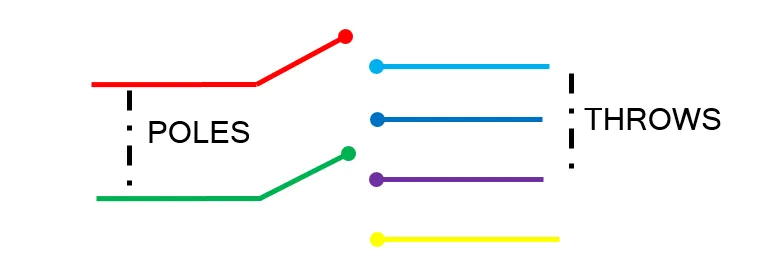
What are Poles?
A pole represents the number of separate input circuits (or current paths) a switch can control. In the image:
- The red and green lines represent two poles.
- Each pole is a separate path for current and can operate independently or simultaneously depending on the switch design.
What are Throws?
A throw defines the number of output paths each pole can connect to. In the image:
- The blue, purple, and yellow lines represent three throws.
- This means each pole can connect to any one of three output terminals depending on the switch position.
What This Diagram Represents:
- Two Poles: Two separate circuits are controlled (red and green paths).
- Three Throws: Each circuit can be directed to one of three output terminals.
- This is commonly called a Double Pole Triple Throw (DP3T) switch or 2P3T.
Applications:
Switches with multiple poles and throws are used in:
- Audio/Video signal switching
- Selector switches in control panels
- Changing operating modes of equipment
- Routing different sources or loads
Types of Switches Based on Poles and Throws
Switches are classified based on two important features: poles (number of circuits controlled) and throws (number of output paths). The most common types of switches include:
- SPST – Single Pole Single Throw
- SPDT – Single Pole Double Throw
- DPDT – Double Pole Double Throw
- DPST – Double Pole Single Throw
- 3PDT – Triple Pole Double Throw
- 4PDT – Quadruple Pole Double Throw
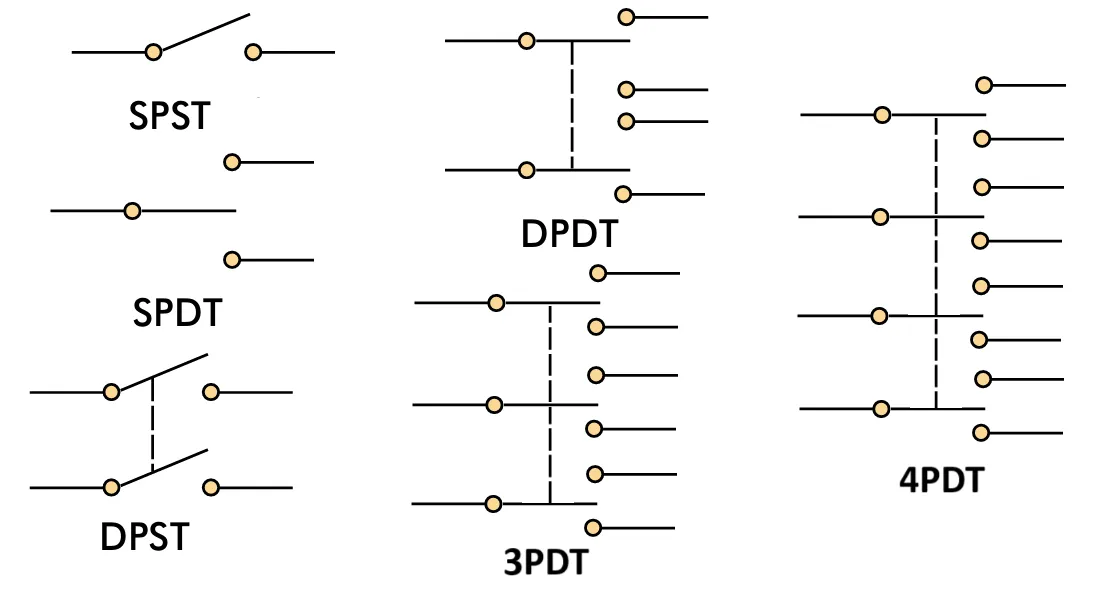
SPST – Single Pole Single Throw
An SPST (Single Pole Single Throw) switch is the most basic form of switch, often referred to as an "on/off switch". It is used to either allow or interrupt the flow of current in a single path.
Key Features:
- Single pole: controls only one circuit.
- Single throw: connects to only one output (either ON or OFF).
- Normally has two terminals: one input and one output.
Working Principle:
When the SPST switch is in the ON (closed) position, it forms a complete path for current to flow through the circuit. In the OFF (open) position, the circuit is broken, and no current flows. It simply acts like a break or bridge in the wire.
Wiring Configuration:
- Terminal 1 (Input): Connected to the power source or supply voltage.
- Terminal 2 (Output): Connected to the load (e.g., light bulb, motor, etc.).
This type of switch does not have a polarity — it can be installed in either direction as long as it's breaking/making the same wire path.
Example Application: Wall-mounted light switches, power buttons on appliances, simple power toggles in machinery.
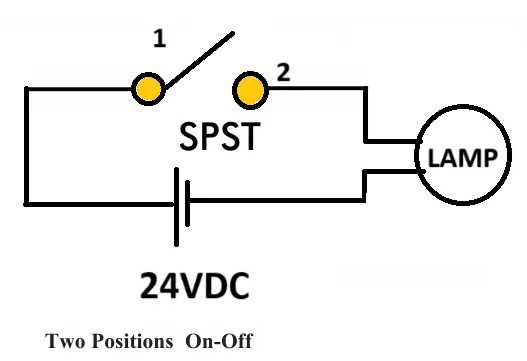
What is a DPDT (Double Pole Double Throw) Switch?
A DPDT switch, or Double Pole Double Throw switch, is a type of electrical switch that has two input lines (poles) and each input can be connected to one of two outputs (throws). This allows two separate circuits to be controlled simultaneously using a single switch.
Each pole has a common terminal that switches between two output terminals. When the switch is toggled, both poles change state at the same time, making it ideal for reversing polarity, switching between two power sources, or selecting between two loads.
Terminals in a DPDT switch:
- 2 Pole Inputs (Common Terminals): One for each circuit
- 4 Throws (Outputs): Two outputs per pole
- Total Terminals: 6 (2 inputs + 4 outputs)
DPDT Switch Wiring Diagram – Controlling Four Lamps
The following diagram shows a DPDT switch used to control four lamps: L1, L2, L3, and L4. Two lamps are turned ON at a time depending on the switch position. This demonstrates the switch's ability to toggle between two different circuit paths for two separate poles.
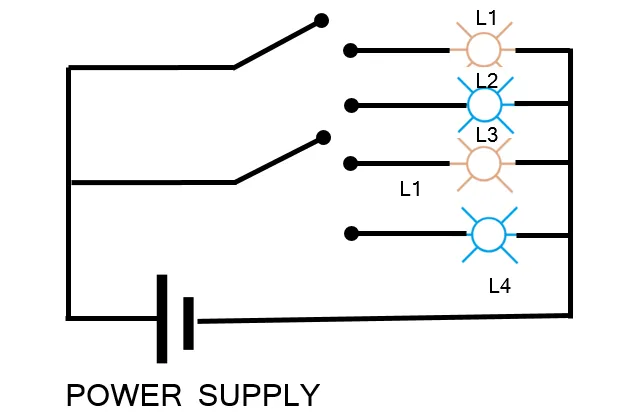
How it Works:
Switch Position 1 (Up):
- Power from Pole 1 is directed to L1
- Power from Pole 2 is directed to L2
- L1 and L2 glow, while L3 and L4 remain OFF
Switch Position 2 (Down):
- Power from Pole 1 is now directed to L3
- Power from Pole 2 is now directed to L4
- L3 and L4 glow, while L1 and L2 remain OFF
Wiring Terminal Details:
| Terminal | Connected To | Description |
|---|---|---|
| Pole 1 (Common) | Power Supply + | Feeds both L1 and L3 through switching |
| Pole 2 (Common) | Power Supply + | Feeds both L2 and L4 through switching |
| Throw 1 (Pole 1) | L1 | Connected when switch is UP |
| Throw 2 (Pole 1) | L3 | Connected when switch is DOWN |
| Throw 1 (Pole 2) | L2 | Connected when switch is UP |
| Throw 2 (Pole 2) | L4 | Connected when switch is DOWN |
| Ground | Return line from all lamps | Completes the circuit to power supply - |
Applications of DPDT Switch:
- Reversing polarity in DC motor control
- Selecting between two audio or video outputs
- Toggling between dual power sources or batteries
- Switching between two operational modes in machinery
SPDT – Single Pole Double Throw Switch
Definition:
A Single Pole Double Throw (SPDT) switch is a type of switch that has one input terminal (pole) and two output terminals (throws). It allows current to flow through either of two output paths — but not both simultaneously. SPDT switches are widely used in applications where a single source needs to be directed to one of two outputs.
The diagram below demonstrates an SPDT switch wired to two indicator lamps (L1 and L2). The switch selects one lamp to turn ON at a time, depending on its position.
Switch Overview:
- Poles: 1 (one input line)
- Throws: 2 (two possible output lines)
- Terminals: One common input terminal, two output terminals
Working Principle:
In this configuration, the SPDT switch directs power from the power supply to either L1 or L2. It works as a selector switch where only one circuit path is closed at a time.
Switch Positions and Output:
- Position 1 (Up): The common terminal is connected to L2. In this position, only L2 turns ON and L1 stays OFF.
- Position 2 (Down): The common terminal is connected to L1. In this case, L1 turns ON and L2 remains OFF.
Wiring Configuration:
| Terminal | Connected To | Description |
|---|---|---|
| Common | +V from Power Supply | Main input to the switch |
| Throw 1 | L2 | Connected when switch is in position 1 |
| Throw 2 | L1 | Connected when switch is in position 2 |
| Return | Ground (GND) | Completes the circuit for both lamps |
Applications:
SPDT switches are useful in situations where a single input must control two possible outputs. Common use cases include:
- Toggle switches for lights or indicators
- Selection between two power or signal paths
- Mode selection (e.g., Manual vs Auto mode)
- Audio routing or relay selection
DPST – Double Pole Single Throw Switch
A DPST (Double Pole Single Throw) switch is used to simultaneously control two separate circuits with a single actuator. It has two poles, each capable of making or breaking a connection independently, but both are operated together by a single mechanism.
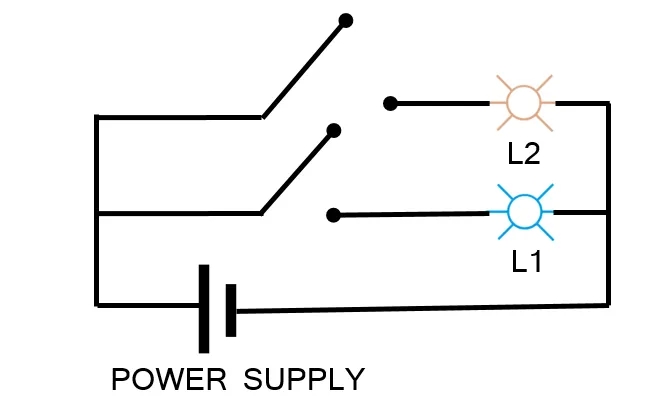
Switch Configuration:
- Poles: 2 (controls two circuits at once)
- Throw: 1 (ON/OFF action only)
- Terminals: 4 total (2 input + 2 output)
Working Principle:
When the DPST switch is toggled to the ON position, it connects both input terminals to their respective output terminals simultaneously. This allows current to flow to two separate loads (in this case, L1 and L2), turning them ON together.
In the OFF position, both circuits are disconnected at the same time, turning OFF both loads.
Wiring Breakdown:
| Terminal | Connected To | Function |
|---|---|---|
| Input A | Power Supply (+) | Feeds Pole 1 (controls L2) |
| Input B | Power Supply (+) | Feeds Pole 2 (controls L1) |
| Output A | L2 | Power to Lamp 2 |
| Output B | L1 | Power to Lamp 1 |
| Return Path | Negative terminal of power supply | Shared by both lamps |
Application Example:
This DPST configuration is commonly used in industrial control panels, motor starters, or safety switches — where it's essential to cut off both live lines (or both positive legs) simultaneously using one switch.
3PDT – Triple Pole Double Throw
3PDT switches control three independent circuits at once, and each pole can connect to one of two outputs. This is useful for switching multi-phase circuits or logic paths.
Working: Acts like three SPDT switches operated by a single toggle. All three paths change state together.
Wiring: Three inputs and six outputs (two per pole).
4PDT – Quadruple Pole Double Throw
A 4PDT switch controls four circuits at once and can switch each to one of two outputs. It is commonly used in advanced control panels, communication switching, or audio systems.
Working: Works like four SPDT switches operated together.
Wiring: Four inputs and eight outputs (two per pole).
What Is the Difference Between Pole and Throw in a Switch?
The terms pole and throw describe two different characteristics of a switch:
- Pole refers to the number of separate circuits the switch can control.
- Throw refers to the number of output terminals or positions each pole can connect to.
In simple terms, the pole is the number of inputs the switch controls, and the throw is the number of outputs each input can connect to.
For example:
- SPST (Single Pole Single Throw) – Controls one circuit and connects to one output (basic ON/OFF switch).
- SPDT (Single Pole Double Throw) – Controls one circuit and connects to one of two outputs.
- DPDT (Double Pole Double Throw) – Controls two separate circuits, each with two outputs.
So, the more poles a switch has, the more circuits it can control. The more throws, the more options each circuit has to connect to.